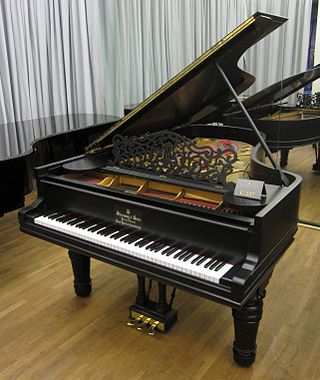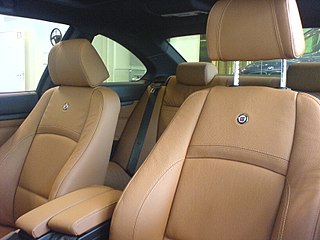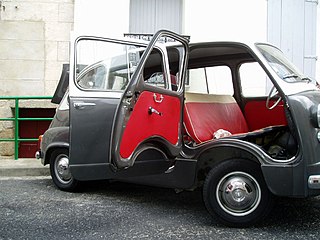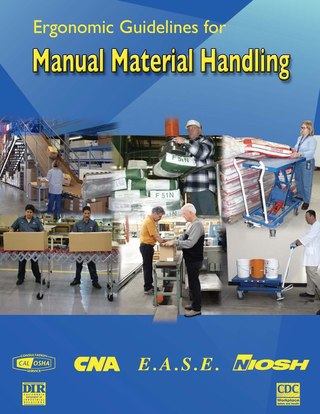
The piano is a keyboard instrument that produces sound when pressed on the keys. Most modern pianos have a row of 88 black and white keys: 52 white keys for the notes of the C major scale and 36 shorter black keys raised above the white keys and set further back, for sharps and flats. This means that the piano can play 88 different pitches, spanning a range of a bit over seven octaves. The black keys are for the "accidentals", which are needed to play in all twelve keys.

A seat is a place to sit. The term may encompass additional features, such as back, armrest, head restraint but also headquarters in a wider sense.

Furniture refers to objects intended to support various human activities such as seating, eating (tables), storing items, eating and/or working with an item, and sleeping. Furniture is also used to hold objects at a convenient height for work, or to store things. Furniture can be a product of design and can be considered a form of decorative art. In addition to furniture's functional role, it can serve a symbolic or religious purpose. It can be made from a vast multitude of materials, including metal, plastic, and wood. Furniture can be made using a variety of woodworking joints which often reflects the local culture.

The Aeron chair is an office chair manufactured and sold by American furniture company Herman Miller. Introduced in 1994, it was designed by Don Chadwick and Bill Stumpf and has received numerous accolades for its industrial design. It is featured in the Museum of Modern Art's permanent collection. It has been cited as the best-selling individual office chair in the United States with over 8 million sold.

A chair is a type of seat, typically designed for one person and consisting of one or more legs, a flat or slightly angled seat and a back-rest. They may be made of wood, metal, or synthetic materials, and may be padded or upholstered in various colors and fabrics.

A standing desk or stand-up desk is a desk conceived for writing, reading or drawing while standing up or while sitting on a high stool.

A car seat is the seat used in automobiles. Most car seats are made from inexpensive but durable material in order to withstand prolonged use. The most common material is polyester.

A footstool is a piece of furniture or a support used to elevate the foot. There are two main types of footstool, which can be loosely categorized into those designed for comfort and those designed for function.

A bench seat is a full width continuous pad forming the front seat of automobiles. The second row of seating in most sedans is usually a bench. The third row of most SUVs and minivans, which may be forward-facing or rear-facing, is also a bench seat.

Bar stools are a type of tall stool, often with a foot rest to support the feet. The height and narrowness of bar stools make them suitable for use at bars and high tables in pubs or bars.

A bicycle saddle, often called a bicycle seat, is one of five contact points on an upright bicycle, the others being the two pedals and the two handles on the handlebars. The bicycle saddle has been known as such since the bicycle evolved from the draisine, a forerunner of the bicycle. It performs a similar role as a horse's saddle, not bearing all the weight of the rider as the other contact points also take some of the load.

Drum hardware is the set of parts of a drum or drum kit that are used to tension, position, and otherwise support the instruments themselves.

A wheelchair is a chair with wheels, used when walking is difficult or impossible due to illness, injury, problems related to old age, or disability.

Pizzicato Pussycat is a 1955 Warner Bros. Merrie Melodies animated short directed by Friz Freleng. The short was released on January 1, 1955.

Bill Carrothers is a jazz pianist and composer based in the Upper Peninsula of Michigan. He has cited Clifford Brown, Shirley Horn, and Oscar Peterson as influences on his development as a musician. Carrothers performs without shoes to better feel the piano pedals, and sits in a chair rather than on a traditional piano bench in order to achieve his preferred seating height.

Ergonomic hazards are physical conditions that may pose a risk of injury to the musculoskeletal system due to poor ergonomics. These hazards include awkward or static postures, high forces, repetitive motion, or short intervals between activities. The risk of injury is often magnified when multiple factors are present.

Rowac was a hardware factory founded by Carl Robert Wagner in 1888 in Chemnitz, Germany which most notably produced furniture for industrial use. Carl Robert Wagner is regarded as the inventor of the steel stool, which among other things was chosen for the workshops and classrooms of the Bauhaus Dessau. Today, mainly stools, chairs and cabinets carrying the Rowac name are traded as antiques.
The right to sit in the United States refers to state and local legislation guaranteeing workers the right to sit at work when standing is not necessary. Between 1881 and 1917, almost all states, the District of Columbia, and Puerto Rico had passed legislation concerning suitable seating for workers. These laws were reforms during the Progressive Era, spearheaded by women workers in the labor movement. The texts of these laws originally almost always applied only to female workers. Most states with right to sit laws have subsequently amended their legislation to include all workers regardless of sex. Largely obscure and rarely enforced for over a century, right to sit laws have obtained new relevance following several high-profile lawsuits against major corporations in California and other states during the 2010s and 2020s. States with current, gender-neutral right to sit legislation include California, Florida, Massachusetts, Montana, New Jersey, Oregon, and Wisconsin. Some states, including New Mexico, New York, Pennsylvania, and West Virginia, maintain gendered language referring to female workers only. Other states, such as Alabama, Arkansas, Connecticut, Idaho, Kentucky, Maine, Michigan, Missouri, Nevada, and New Hampshire, as well as the District of Columbia, repealed their right to sit laws between 1972 and 2015. Mississippi and Hawaii are the only states to have never had right to sit laws. Right to sit laws have been enacted at the local level in several cities, including Portland, Oregon and St. Louis, Missouri.

A multifunctional furniture is a furniture with several functions combined. The functions combined may vary, but a common variant is to incorporate an extra storage function into chair, tables, and so forth, making them so-called storage furniture. Multifunctional furniture can accommodate more efficient use of living spaces. Lack of space can be an important reason for choosing such furniture, but combination furniture is also seen in larger homes for more space-efficient utilization. Historically, furniture with transforming mechanisms was called "mechanical furniture".



















